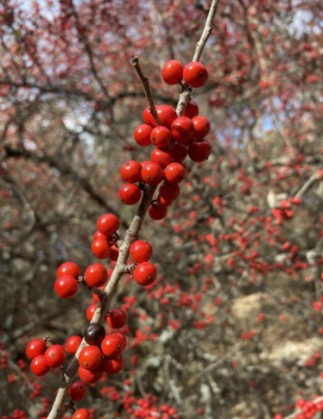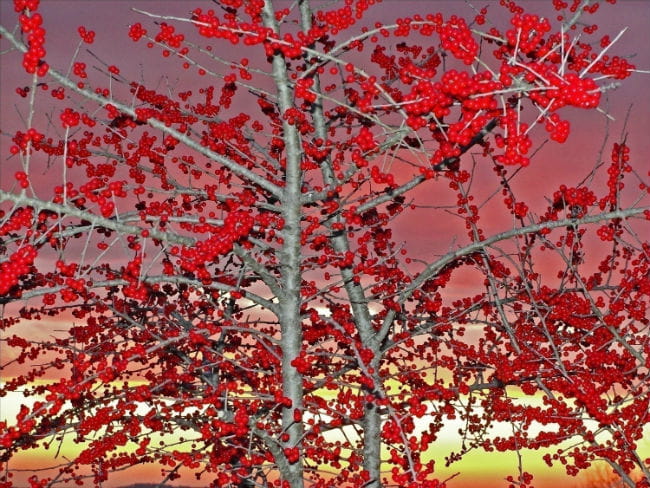Just because the sky is gray doesn’t mean your landscape has to be!
When you think of winter, you may think of gloomy, drab colors. But just because the sky is gray doesn’t mean your landscape has to be!
I sat down with SAWS irrigation consultant Gail Dugelby to chat about how to incorporate vibrant and drought friendly seasonal colors into your landscape.
So, grab a cuppa and snuggle up in your favorite arm chair — Gail has a winter wonderland of wisdom to share!
What’s the deal with seasonal color when we get to the month of December?

When we say seasonal color, it helps to expand your perception of the idea. Winter doesn’t mean your landscape has to reflect a bleak landscape. In the winter, you may lack color from wildflowers and budding blossoms, but there are many other aspects in your yard that provide color and texture. Our evergreens and plants that hang on until cold weather arrives shine when the deciduous go dormant. Juxtaposing different plants, flowers, textures and colors helps your yard stand out. When the deciduous drop, the bare branches show off their skeletons, standing out against Texas’ winter colors like the very blue sky we tend to see in the colder months leading up to spring.
Also, don’t forget that nature has seasonal colors you may have not considered. If you need inspiration, just take a nature walk.
What are classic colors for plants in winter?
Evergreens are great options — Rosemary is a good one and it doesn’t have to stay in a pot. It can go right in the ground after the holidays. People tend to go straight for poinsettias, cyclamen and pansies when they’re shopping for holiday color, but they’re not always up to the challenge for our climate. You’ll spend a lot and likely need to replace them after a couple of months.
What do you approve of?
I recommend sticking with native plants as well as a few “neighborly natives.” One benefit of native plants is they’re good for wildlife, which add seasonal color of their own. Like in December and January, cedar wax wing birds will land on deciduous trees (like possum haw) to eat the berries. Their vibrant brown, yellow and red feathers add texture — and they resemble holiday ornaments among the bare branches.
Gail’s approved seasonal colors list:
- Texas mountain laurel: unique March flower with evergreen leaves that stand out when others are falling in the colder months.
- Ashe Juniper: the pollen adds a pop of red-brown.
- Blue bonnet rosettes: a hardy plant that doesn’t require any water. One special characteristic is that when it freezes, little crystals appear but don’t cause the plant to die.
- Inland sea oats: bright green seed head that can be very long, but horizontally it’s paper thin! A brownish fall color that will bloom again in the spring.
- Gay feather: also known as blazing star, it adds texture and varying levels to your landscape. It’s known to grow in the Hill Country.
- Frostweed: roots explode creating different shapes resembling snowflakes during the first freeze.
 |
 |
Ever wonder how a type of grass can add a seasonal vibe? Well, wispiness and movement add a unique touch of winter whimsy.
One of Gail’s favorite plants is Possumhaw Holly because of its small green leaves and berries that turn bright red. Right after Thanksgiving, leaves fall off, leaving lots of berries on bare branches.

What do you mean by neighborly natives?
Neighborly native plants are plants that we have brought over, have successfully grown, but are not invasive. Because our climate has warmed up, plants that are not from here are able to thrive.
Her list of neighborly native plants:
- Esperanza (South of us): yellow color with a trumpet shaped flower.
- Pride of Barbados (South of us): variety of yellow, orange and red flowers.
- Century plant: yellowish green stalk.
- Christmas cactus: white, pink, purple and red flowery cactus.
- Amaryllis: a flower bulb full of color.
- Certain succulents: various shapes and colors; some species of cacti turn different colors when it gets cold.
- Certain cactus (from the west and south of us): texturized plant that comes in various shapes and sizes.
- Rosemary: prickly green shrub with small flowers.
- Liriope: stringy leaf green shrub with purple flower bulbs.
- Ornamental grasses: Gulf Muhly (South towards the coast) and Mexican feathergrass (West Texas), both wispy thin grass shrubs with lots of movement.
- Bougainvillea: pink, fuchsia tree with bare branches and a pop of green leaves.
- Red yucca (West Texas): dull green stringy shrub with pop of pink and coral flowers.
Can some of these native plants can be used to bring seasonal color from your landscape into your home for decor?
Sure! For example, century plant will catch anyone’s attention. Amaryllis comes in a variety of colors, not just red.
Are they good options for the fifth year of drought?
Yes, if the plant can survive in nature without a lot of water, they’re ideal.
Taking time to plan and decide what to plant to spice up your landscape is important. Enjoy the process of crafting your perfect landscape with native and neighborly native plants.


